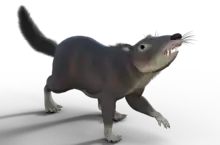Aegialodontia
Aegialodontia is a clade of extinct early mammals, close to the origin of Boreosphenida. The clade includes some of the oldest known tribosphenic taxa, until the discovery of Tribactonodon from the Berriasian Durlston Formation in 2001, Aegialodon from the Valanginian Wadhurst Clay Formation was the oldest taxon with the tooth form.[1] The Aptian to Albian taxon Kielantherium from Mongolia, formerly a synonym of Aegialodon, is also within the group, sister to Aegialodon within Aegialodontidae.[2]
| Aegialodontia | |
|---|---|
| Scientific classification | |
| Kingdom: | Animalia |
| Phylum: | Chordata |
| Class: | Mammalia |
| Clade: | Tribosphenida |
| Supercohort: | †Aegialodontia Butler, 1978 |
| Genera | |
| |
References
- Sigogneau-Russell, D.; Hooker, J.J.; Ensom, P.C. (2001). "The oldest tribosphenic mammal from Laurasia (Purbeck Limestone Group, Berriasian, Cretaceous, UK) and its bearing on the 'dual origin' of Tribosphenida". Comptes Rendus de l'Académie des Sciences, Série IIA. 333 (2): 141–147. doi:10.1016/S1251-8050(01)01612-3.
- Lopatin, A.V.; Averianov, A.O. (2007). "Kielantherium, a basal tribosphenic mammal from the Early Cretaceous of Mongolia, with new data on the aegialodontian dentition" (PDF). Acta Palaeontologica Polonica. 52 (3): 441–446.
This article is issued from Wikipedia. The text is licensed under Creative Commons - Attribution - Sharealike. Additional terms may apply for the media files.





